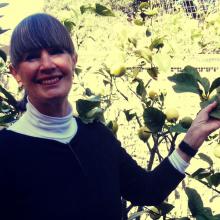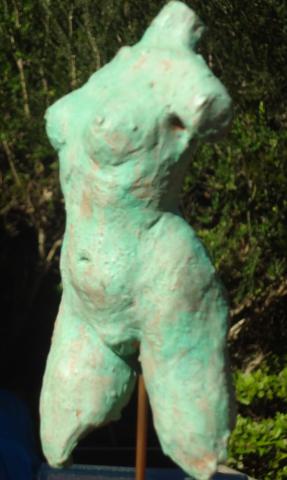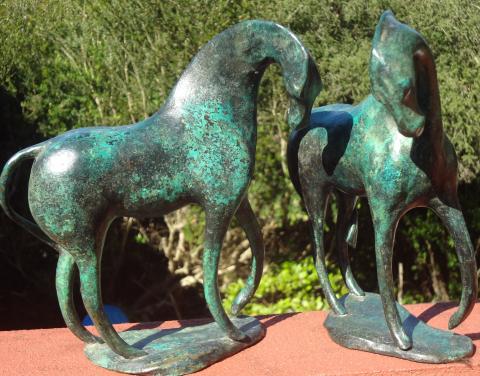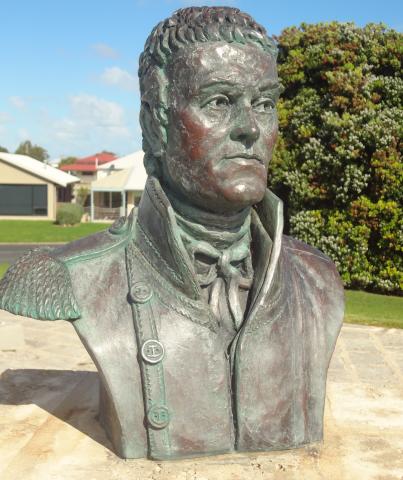
PATRICIA MOSELEY
F.R.S.A.S.A
SCULPTOR
It took me almost 50 years to find my own voice and say exactly what I thought. My father had a nervous breakdown at nineteen—he was the only mechanic when they were breaking up a lot of country at the back of Keith, towards the Coorong. It was called Bruce's Plain and of course this was before trace elements were discovered, long before then. Dad broke up that country driving 24 hours around the clock. He just lay awake waiting for the machinery to break down and he was the only mechanic. So he was packed off to South Africa. Later, if he got up in the morning and said black was white because he hadn't been able to sleep and he had taken numerous whiskies, hot and cold showers, and so on, I learnt to agree, to keep the peace.
And then, after I married I had to learn to conform somewhat, so it wasn't really until after I was divorced at 45 after 20 years of marriage that I decided I wanted to follow my cultural instincts. Although I loved my horses, cattle, sheep and life on the land, there was more to life than that. It was an interesting period: I decided to do Arts at university and anthropology, which I loved. I went in as an adult student. Dr Gray was the most fascinating lecturer, he picked you up in enthusiasm. We did all of the lectures and the essays, and so on, but because I am dyslexic I always have problems with exams. I've got the sort of mind that can look at something and say, that's that, but I can't tell you why. I can't think sequentially and that's probably why we get on so well. But I still have to be very careful when I go to say, “you go left and then right”, because I may not actually say it that way.
Early on I brought two families together. We had three children at three different schools in three different levels. At that stage my husband Greg was working one specific learning problems with children. Only he was expected to intervene more as a psychologist and needed those qualifications, and at that stage I had a bit of money, so I said, "I'll look after you, while you go back.” The long and the short of it was he discovered the beautiful nineteen year-olds, and so he moved out and Greg's son Luke lived on with me, and one by one the kids peeled off.
But getting back to that year at university, 1986—I was interviewed, something came up in The Advertiser, about how women are thinking. There was a survey. I remember Fleur and Luke leaning over my shoulder, and I was ticking an answer a, b, or c, and they said "Oh Mum, is that what you really think--we never knew!". A lady turned up to interview me, a bit late, and I wasn't really prepared mentally, and I did end up saying if men put more into loving a woman they'd get a hell of a lot more back. It was interesting, inasmuch as a lot of old school friends and their husbands were quite withdrawn over my comments. I had opinions and they were still in that social place where you don't really speak out. But people that I hardly knew, like a jeweller that I used to go to, who said, "Oh Pat, fantastic, I've got you on the front of my fridge".
It was also in that short period at Adelaide University that I met Helen Zachariah. She was in charge, with another lady, of the University craft area; she's still a great friend and we are virtually the same age, within about 18 days. She had walked out of Germany with her two brothers and a little dogcart. Her mother was a trained physio and eventually they came to Australia. Helen used to do quite a bit of glass work at the Magill TAFE and one day she said to me "Pat, who taught you dressage?" I suddenly connected I had met a Hermann Heyer, who was training Peter's horses because he was aiming for the Olympics--this was back in 1957/58. My father used to help Hermann out with some hay and he gave me quite a bit of help with my horses. I said "Helen, was Hermann Heyer your stepfather?." Because Helen had lost her father and one of her earliest memories was the rifle butt on the door and the Russians taking her father. Anyway, it was Helen who said, "Come on Pat, you haven't sculpted for five years--I want a bust of Mary Lee”—one of the earliest South Australian suffragettes.
I had started sculpting because I wasn't very happy. Joe and I never had an argument, but we never an in-depth. I found travelling overseas on my own wasn't really sufficient, when you are married and have a family. When my son Angus had been born I always said I wanted to do some sculpting but I left it until I wasn't very happy. He had just gone to school and I had my grandfather's woodcarving tools. So I started sculpting in 1980: I did a relief of my daughter, Fleur. I worked on a limestone ashlar block left over from where we'd built on. I realised then that I had a photographic memory because children won't sit still. I did a bust of Angus, too. I used grandfather's chisels and just started. Of course, working limestone, just where you want to do an eyelid you will sometimes find a shell or bit of quartz.

Then I went overseas, to Europe. I had met Hermann Göbel in the Seychelles in about 1980, with my mother. Hermann was very cultured--he opened up my mind. He said "I will give you a trip off the beaten track if you ever decide to come to Europe" and that's how I ended up there. Then I came back and got on with my work. My mother died shortly after I came back from Europe and I had that to deal with.
I went back to Europe in 1984 to see whether I would stay there. I think Hermann would have put me on a pedestal but I had a family back here, so I put myself back together again in a forest in Iceland. And so I came home and said to poor Joe, "Sorry, but I am getting on with my life". And so I've had periods of very intense sculpting because it completely relaxed me. When I'd come back inside after I'd been sculpting, when I first started, I just looked ten years younger—all the stress just goes.
My parents were both very artistic. Dad was very good in the forge. He made all the curtain rods in Amberleigh, he made brush fences. My parents were second cousins, and so I've got a double dash of Derrington: I've got a watercolour at home, the old washerwoman by my great grandfather, Edwin Derrington: he couldn't paint faces so all his women are turned away. Whereas I have specialised in portraiture.
I went to Italy in 1989 and Hermann and I had Christmas together. Then I went down to Italy to the De Medici Art School. I had asked round when I first moved to Adelaide because I really wanted somebody to take me by the hand and say, "Right Pat, you do this today, that tomorrow and I expect that by the end of the week". There was nowhere in Adelaide that taught classical sculpture. I did meet up with a fellow who used to work at the museum and he had been to the De Medici Art School, and so I applied to go there. I went down to Rome and I had a room in a house that was three stories high, that looked straight down at the Pantheon. It was wonderful: I walked everywhere.
Then I went to Florence. I was there for about six weeks and it was basically to see if I would go back the following year to the Art School, which I did. It was a lonely experience. I was looking forward to interacting with other sculptors and I was actually just slotted into three hours one day, an hour and a half another day. And while it was one-on-one I just found my tutor wasn't teaching me anything. She was working in a style more like that of a palette knife. So I just went back to the director of the Art School and I said, "Look I'm not happy" and he sent me off to Yvonne De Palma. We had the most wonderful philosophical discussions, and I did get to the stage of doing a maquette about half a metre high and learning how to wire all of the fingers and everything. But the day before I was to return to Australia, I broke it—I had to break it, I couldn't carry it home, it was all plaster. I had done the original in clay and then cast it and so I broke it and came back to Australia. Basically I got on with it.
I was living at Ashton, in the Adelaide hills, I bought a lovely property there. I loved Ashton, it's still my favourite place. Robe is a beautiful place too but I'm probably more European than Australian. I don't like gums. I just love the cacophony of colour in autumn. In one year in Ashton I planted about 1,300 trees. Whenever I got down a bit I'd go and buy another 50 trees.
Mostly in my sculpture I worked with photos, I don't draw anything. The original is always in clay, and then I send them to a very good foundry which does the casting for me. I hated phoning up and asking people if they would sit for me, but Hugh Stretton was one that I did phone. And of course, we had great discussions and he said "Are you going to do portraiture for the rest of your life?" And I said "Possibly". Actually I enjoy ‘eliminating’ in figurines, I just like to give the movement, whether they are talking or singing. Horses I ‘eliminate’ too so that they are more modern. But I hated phoning up. I'd be a mass of nerves.

Back in the 1990's there was quite a lot of money for councils and it would come out through something like ‘Art for Public Places’ in Adelaide. They would call for expressions of interest and then you would go through a selection process; they would pick two or three people and you would be paid $2,000 to do a maquette. I was shortlisted to do Sir Donald Bradman, Dame Roma, and Don Dunstan. I was always the bridesmaid! I once said that to Tim Thomson, who owned the foundry, and he said "You know Pat, you don't belong to the right latte set—you speak your mind and Adelaide doesn't like it!"
So I was operating out of Ashton—and then there was Robe. Sliding doors! Fleur was married and living in Robe, and she took on the first coffee shop. And then The Caledonian Inn came up for sale. In the meantime my ex-husband Joe had remarried six months after we were divorced which rather surprised me, but these things happen. Joe would have bought the Callie as an investment. But his wife said "I don't like pubs" so that was the end of that, and it was sold to someone else. The lease came up and then Fleur and David ran it.
I used to come down and help over Christmas and New Year. I did everything from turn-around washing, watering the lawns, dish pigging. One time, I happened to be walking down Barrowman's Drive. I had my hair braided, which I quite often did in those days. John was walking up there and we said hello, and kept walking. I went back to Ashton. But John was in the front bar of The Callie and said "Fleur, I want to draw some braided hair" and Fleur said "Oh, my mum does hers much better than I can”—because I’d plaited so many horses tails, being ambidextrous. So Fleur said "I'll give you mum's silent number"—she did phone me and tell me.
And then John and I talked a lot on the phone, and two months later, the very day John was to come and meet up at Ashton, he nearly died of a bee sting at Mt Pleasant. He is lucky to be alive. He was up on a ridge cap photographing and just had enough time to hand his camera to Bill, the owner of the place, and just went out. The doctor was in the cattle yard inoculating his cattle so he arrived with the adrenaline drip and saved John's life.
And so we had those very expensive telephone calls, because it was hard for John to get up and see me. It would have been August and he had an exhibition on in Robe, so I said I would come and have a look. I'd always thought of John as being a very good friend—I'd been on my own for about eight years and I was very happy at Ashton. But I started missing him and he started missing me, and so I said, "Well, we can give it two years or twenty—let's see how we go at that stage in life.”
I sold Ashton. A lot of people said "How can you close the door after what you've made of this property?" The house was made out of 100 year-old bricks and it was very English, with timber and panels of bricks. I'd been there from 1986 until 1998. Twelve years, but I'd got all of the trees up so that you could get a slasher under them, and I kept it like a park. It was almost five acres. It was a beautiful spot. I loved Ashton, I really did. We had a communal garden. Milton Moon, the potter, dug the potatoes down the hill so it ended up terraced.
I ran into financial problems because I had helped a former business partner with a mortgage on my freehold property for a venture that went down—and that was something that, okay, I did it and it backfired on me. I ended up with a $150,000 mortgage and only my art to live on.
My property at Ashton was called Bakehouse Cottage because it had the original Bakehouse on it, dating from the 1850's. I’d always intended to create a studio there. You know how a lot of the old properties were square, but the Bakehouse sort of got squished and had the door across the corner, for selling the bread. There were a lot of hay and old buggies in it but it had great feeling. Quite often people would stop and have wedding photographs there. Unfortunately on Ash Wednesday it went up. It was just down the hill from the house. The flames had created a lovely pink ochre on the walls. This was about the period I met John and he offered to come and help me with Bakehouse Cottage but I said "Thank you, but no"—he didn't have any more than I had. I said "No, it's time to close the front door" and although people said "Oh Pat, how can you!", I said "No, just close the front door. Just walk away.” I came down to Robe in 1998.
John reminded me last August, "Do you realise we've had 20 years?” John had been on his own for some time and he’s a Leo and I'm a Cancerian, and so we did a bit of a shuffle after being very independent for many years. I'm a home-body, bit soft, and you know, Leo's like organising you, and when you're used to organising yourself. . .
But I grew up with a father who used to say "Babs, there's the horse, there's the show, get yourself to it". So I've always earned my own money, even when I was married, I bred horses and was always independent. When I was with Joe I furnished our home, Petanga, and put the carpets in and so I've had that independence bred into me from a very early age. If I wanted any more money, well, there was always the tractor to drive. I worked like a man and that is why I have back problems. Dad always said, "Oh don't lift a sheep, just tie its legs", but was there ever a man to go back and pick it up? So I'd have a seventeen-hand horse, ex-racehorse and a kicking wether—the horse not very happy about having a sheep shoved onto its withers! Do you know, I never told my parents where I was going. I used to go over to Andy Gray's sand hill a couple of miles away and I knew if I dug into the bottom of the sand dune I would get water coming in—it would be milky, but your dog could always have a drink and you could always get a cup of water and I thought nothing of going over by horse.
The three years I was a boarder at Girton, now Pembroke, my parents never came to a speech night. When I started there I was twelve and 18 months younger than the rest of the class, because all the other girls were correspondence-trained. We were a pilot group, so at fifteen we could do Intermediate subjects or Leaving subjects. However, my mother said "Well, sweetheart, you either go back or you do something when you leave school” and I said "No, I'm not going to repeat what I've done.” So I chose Mothercrafting, being the shortest possible course I could think of. A friend said "Well, Pat, you can travel with that but you may need a hatpin to keep the fathers at bay!" Unfortunately I picked up Paronychia from a mother at the hospital. So I'd done all the theory but I couldn't complete the practical. But it didn’t stop me from working.
When I came to Robe I worked on my sculpture at the Bush Inn. It was just myself and one or two others who came in and out. It was the most beautiful feeling out there—just Judy and I ended up together. We'd light the fire and we had two kilns and I was only doing figurine work. Judy was very good on the potter's wheel. It was sad when that closed. My clay busts, which had been cast in bronze, I used to get back from the foundry and then rehydrate them. So we would drive down the Coorong with a bust bolted down to the floor of the Ford station wagon we had in those days, with the head of the bust peering at you in the rear vision mirror—it was bolted so that if we hit a kangaroo, it wouldn't join us in the front seat. John gave up painting—I actually started him on his house design work by asking him to design a place for me. He did several lovely designs which is how we've ended up with the little place we've got now—minimal housework!
Getting back to the busts: I would rehydrate them back here (getting moisture back into the clay) and cut them in half over the top of the head. Then you put a ‘key’ in behind the ear and down the neck (to line it up later), and as you are splitting them you need someone to catch the other half—I build up a bust and it’s solid. I might have a little paper mache in the middle so I can just move the head, with lead around it and then nailed onto the main peg. As you cut it in half you have to catch it and then gently lay it down. Then you cut it out to a thickness of about ¾”, the whole head; and then you make up a slip, which is clay mixed with water until it’s like a thick cream. On the face of the cut around the head you crisscross it and paint it with the slip and then put it back together again. Then you dry it and hope it all hangs together!
I learned the basics very early on. However, I quickly realised that the country bloke who taught me was slapdash and that every process is only as good as the previous. A bust is only as good as you originally make it and then your casting is only as good as your plaster-casting. I learnt to blow up noses of the busts (all very intimate) to get it right. I can teach the basics.
John does beautiful portraits too. He's very versatile. People say to him, "Let me see what you’re painting” but John says "I haven't painted for ten years, there's no money in it.” I mean, you are six months painting for an exhibition and then you still have to sell them. John and I both realise that a lot of people who buy sculpture find it—not intrusive, but it does demand a position—whereas with a painting people think "Oh well, can move that painting aside, and put that one there to match the setting.” But sculpture has its own spot.

I think it helps to have an eidetic mind where you can envisage all the bits as a whole. I think in pictures. Show me a picture or a face and I will never forget it, but I will forget names and numbers and things like that. I can close my eyes and decorate a room or I can look at a house plan and see how it should be.
I think a lot of women are frightened, especially women who have had financial security, they are frightened to step out of that and they are very much afraid of switching from one path to another, and consequently I think they miss out on a lot. I always found, even as a teenager, that I was never part of the party scene. My parents treated me as an equal and they were very cultured and intellectual. I read Lawrence Durrell’s Alexandria Quartet when I was about fourteen. So consequently I always felt outside—an outsider.
And when I came to Robe, that really hit me. Keith had been just developing when I was growing up there. It was very much a quiet little country town but it had its community. There was the Keith Community Centre. My father and two other men post-war bought the land which became the oval and all of that area. My father was always active; half the time when they had dinner guests coming, he was out of the shower, on the phone, not a stitch on, guests arriving at the front—every night he was on the phone, pretty much. And then there is the Don Moseley Playground, which is named after him, and he started the Keith Community Kindergarten. I’d like to see more of that in Robe: there's a lot of money here but it’s not easy to get support for community work. We need more of it.